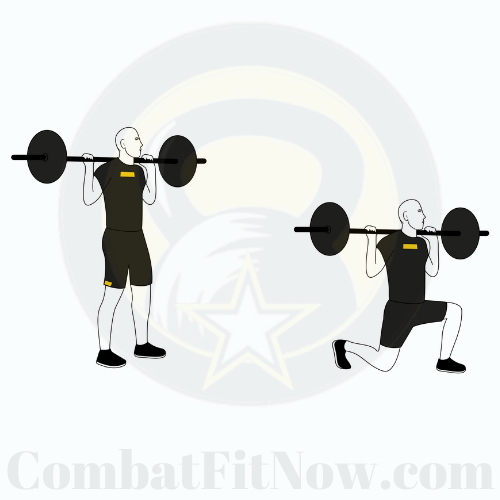Barbell lunges are a great compound exercise that targets your quadriceps, hamstrings, glutes, and calves. Here’s a step-by-step guide on how to perform barbell lunges with proper form:
Video Instructions On How To Do Lunges with Barbell
Equipment Needed:
- Barbell
- Weight plates
- Squat rack or a cleared space
Instructions:
- Set Up:
- Load an appropriate amount of weight onto a barbell. The weight will depend on your fitness level and goals.
- Place the barbell on a squat rack at about chest height. Ensure the bar is evenly loaded with weight on both sides.
- Body Positioning:
- Stand facing the barbell with your feet shoulder-width apart.
- Step forward with one foot, positioning it far enough in front so that when you lower your body, both knees form a 90-degree angle.
- Your back foot should be on the toes, and your front foot should be flat on the ground.
- Grasp the Bar:
- Reach forward and grip the barbell with both hands, slightly wider than shoulder-width apart. Your palms should be facing forward.
- Lift the Bar:
- Lift the barbell off the rack and take a step or two back to clear the squat rack.
- Lunge:
- Lower your body by flexing the knee and hip of your front leg. Descend until your rear knee nearly touches the ground.
- Ensure that your front knee is directly above your ankle, and your back knee is hovering just above the ground.
- Keep your torso upright, and your back straight. Avoid leaning forward.
- Push Back Up:
- Push through the heel of your front foot to raise your body back up to the starting position.
- Bring your rear leg forward to return to a standing position.
- Repeat:
- Complete the desired number of repetitions on one leg before switching to the other.
- Breathing:
- Inhale as you lower your body into the lunge.
- Exhale as you push back up to the starting position.
- Tips:
- Keep your core engaged throughout the movement for stability.
- Maintain a controlled pace, focusing on proper form.
- Start with a lighter weight to ensure you have the technique down before adding more resistance.
- Safety Precautions:
- If you’re new to this exercise, it’s advisable to have a spotter or use safety bars in case you need assistance.
Remember, it’s essential to start with a weight that allows you to maintain good form. As you become more comfortable and stronger, you can gradually increase the weight.



